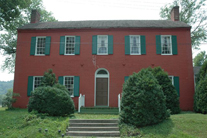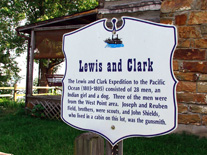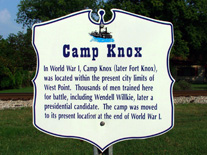 West Point is one of the oldest towns in Kentucky. The first settlers arrived at the Mouth of Salt River in 1776, but for the first 20 years the settlers were time and again driven back to the more populated areas in Southeastern Kentucky by constant Indian attacks.
West Point is one of the oldest towns in Kentucky. The first settlers arrived at the Mouth of Salt River in 1776, but for the first 20 years the settlers were time and again driven back to the more populated areas in Southeastern Kentucky by constant Indian attacks.
In 1796, following the peace treaties signed between the Kentuckians and the Northwestern Indians tribes at Greenville, Ohio, the area became open for permanent settlement, and the town of West Point was officially established. The town was named West Point because at that time it was the western-most outpost of the so-called English civilization as you came down the Ohio River.
The founder of West Point was James Young, a young Virginian, who owned the land grant on which the town was established. In fact he owned every lot and even the streets in the town. Following a lawsuit over the existing over lapping land grants, the courts recognized him as the proprietor of West Point. Young lived practically his entire life in West Point and amassed quite a fortune in his various business enterprises.
Today there is a river walk along the banks of the Ohio River named in honor of James Young, as well as the bridge that carries the U.S. 31W highway traffic across the Salt River. Young was one of the investors that built the original turnpike that connected Louisville and Nashville, Tennessee.
In its early years, long before the airplane, railroads, or super highways, West Point became the river port for practically all the commerce coming into and leaving a large portion of Kentucky, from here to the Tennessee border. Large warehouses were built on West Point’s riverfront where merchants and farmers would store their merchandise awaiting flatboat and later steamboat transportation.
 West Point was a frontier town and most of the trade was down river to New Orleans, which was at that time under Spanish control. When Lewis and Clark made their historic journey from Clarksville, Indiana to the Pacific Ocean, they organized their expedition and recruited experienced men to attempt the long journey. Of the nine men from Kentucky who made up the nucleus of the group, three of those men were residents of the nearby area. One, John Shields, the oldest member and only married man in the group, lived in West Point with his wife and daughter. The two Field brothers, Reuben and Joseph, lived nearby.
West Point was a frontier town and most of the trade was down river to New Orleans, which was at that time under Spanish control. When Lewis and Clark made their historic journey from Clarksville, Indiana to the Pacific Ocean, they organized their expedition and recruited experienced men to attempt the long journey. Of the nine men from Kentucky who made up the nucleus of the group, three of those men were residents of the nearby area. One, John Shields, the oldest member and only married man in the group, lived in West Point with his wife and daughter. The two Field brothers, Reuben and Joseph, lived nearby.
West Point was the quintessence of river towns with life and commerce centering mostly around the river. It was the lifeline of an expanding nation and many people of renown visited and observed life in West Point. John James Audubon was one visitor and he wrote of his stop at Young’s Inn in his essay on the Passenger Pigeon. Henry Clay, Andrew Jackson, Theodore Roosevelt and John Muir were other visitors.
West Point has a rich military history also. When the Civil War broke out, the Union Army invaded Kentucky and erected a fortification on the hilltop overlooking West Point. Work began early November 1861. It was named Fort Duffield and its purpose was to protect Louisville from attack by Confederate forces as well as to defend the huge supply base at West Point. This historic site is open year round for visitors and is reached via a quarter mile hiking trail.
 In August 1903, the War Department established Camp Young in West Point as a temporary army training camp. Throughout that summer, thousands of soldiers from military installations in 16 states together with the militia from Ohio, Indiana and Kentucky participated in large-scale maneuvers that demonstrated the suitability of the area for a permanent military installation. In 1918 during World War I, land was purchased for another installation, which was called Camp Knox. Both Camp Young and Camp Knox were the forerunners of today’s Fort Knox, Kentucky, which was established in 1932.
In August 1903, the War Department established Camp Young in West Point as a temporary army training camp. Throughout that summer, thousands of soldiers from military installations in 16 states together with the militia from Ohio, Indiana and Kentucky participated in large-scale maneuvers that demonstrated the suitability of the area for a permanent military installation. In 1918 during World War I, land was purchased for another installation, which was called Camp Knox. Both Camp Young and Camp Knox were the forerunners of today’s Fort Knox, Kentucky, which was established in 1932.
West Point has been home to many businesses and industries. One of the first industries was a sugar refinery that began operation shortly after 1800. Salt was a major industry in the locality for many years. A thriving boat building industry once existed. In 1895 a brickyard was established for the making of building bricks. The West Point brickyard played an important role in the history of the area. Though the remnants of the brickyard are not available for public visitation, there are numerous other sites of historic interest in the area.
West Point is home to one of the few remaining Rosenwald Schools which are historically significant as reminders of the contributions of Julius Rosenwald, Booker T. Washington, and the Tuskegee Institute to rural African American education in Kentucky and 14 other southern states. Constructed in 1926, the school served as the only elementary educational facility for African Americans in West Point and Northern Hardin County. The colored and white schools blended in West Point in 1956, with the black teacher, Mary Hawes Baxter being accepted into the mainstream school system. She became a highly respected part of West Point education and the school library is named in her honor. Anyone interested in the restoration of the West Point Rosenwald School is invited to contact the alumni organization Fruits of Change, Inc., 1704 Cypress Street, Louisville, KY 40210, 502-778-1403,
fruitsofchange@aol.com
The people of West Point are proud of their rich history. Part of that history includes floods from time to time, but the spirit of the City of West Point prevails. Today, preservation and progress go hand in hand in this small river town on the beautiful Ohio River.
The fascinating story of the people and events in the history of West Point can be found in numerous books authored by Richard A. Briggs and can be obtained by contacting: